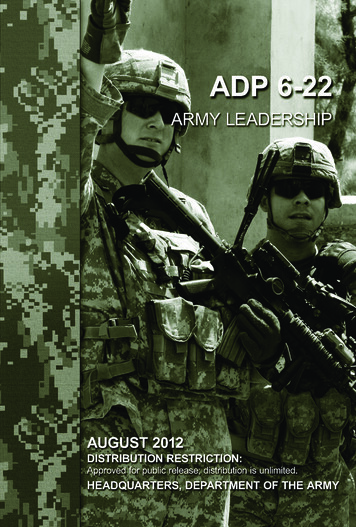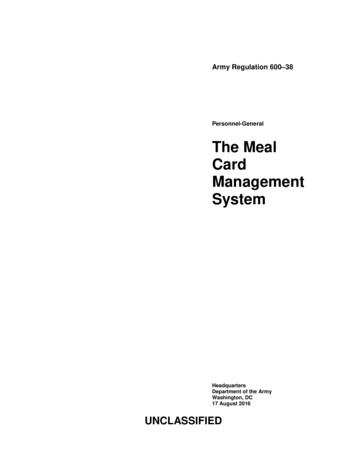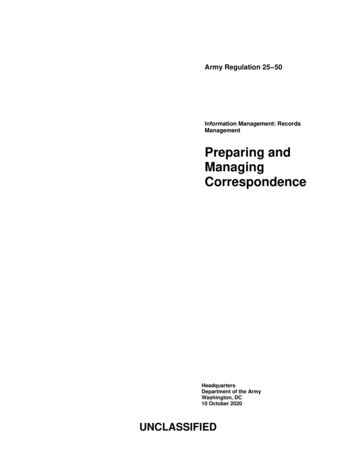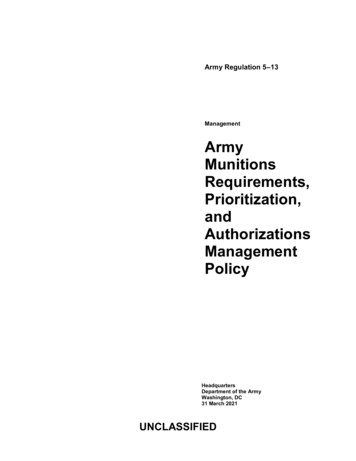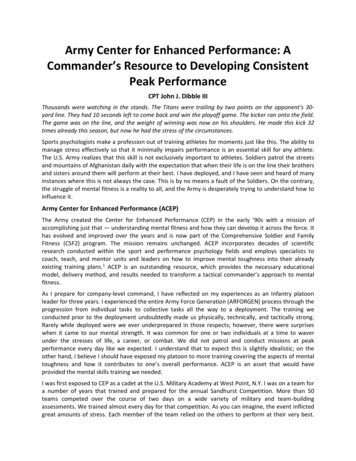
Transcription
Army Center for Enhanced Performance: ACommander’s Resource to Developing ConsistentPeak PerformanceCPT John J. Dibble IIIThousands were watching in the stands. The Titans were trailing by two points on the opponent’s 30yard line. They had 10 seconds left to come back and win the playoff game. The kicker ran onto the field.The game was on the line, and the weight of winning was now on his shoulders. He made this kick 32times already this season, but now he had the stress of the circumstances.Sports psychologists make a profession out of training athletes for moments just like this. The ability tomanage stress effectively so that it minimally impairs performance is an essential skill for any athlete.The U.S. Army realizes that this skill is not exclusively important to athletes. Soldiers patrol the streetsand mountains of Afghanistan daily with the expectation that when their life is on the line their brothersand sisters around them will perform at their best. I have deployed, and I have seen and heard of manyinstances where this is not always the case. This is by no means a fault of the Soldiers. On the contrary,the struggle of mental fitness is a reality to all, and the Army is desperately trying to understand how toinfluence it.Army Center for Enhanced Performance (ACEP)The Army created the Center for Enhanced Performance (CEP) in the early ’90s with a mission ofaccomplishing just that — understanding mental fitness and how they can develop it across the force. Ithas evolved and improved over the years and is now part of the Comprehensive Soldier and FamilyFitness (CSF2) program. The mission remains unchanged. ACEP incorporates decades of scientificresearch conducted within the sport and performance psychology fields and employs specialists tocoach, teach, and mentor units and leaders on how to improve mental toughness into their alreadyexisting training plans.1 ACEP is an outstanding resource, which provides the necessary educationalmodel, delivery method, and results needed to transform a tactical commander’s approach to mentalfitness.As I prepare for company-level command, I have reflected on my experiences as an Infantry platoonleader for three years. I experienced the entire Army Force Generation (ARFORGEN) process through theprogression from individual tasks to collective tasks all the way to a deployment. The training weconducted prior to the deployment undoubtedly made us physically, technically, and tactically strong.Rarely while deployed were we ever underprepared in those respects; however, there were surpriseswhen it came to our mental strength. It was common for one or two individuals at a time to waverunder the stresses of life, a career, or combat. We did not patrol and conduct missions at peakperformance every day like we expected. I understand that to expect this is slightly idealistic; on theother hand, I believe I should have exposed my platoon to more training covering the aspects of mentaltoughness and how it contributes to one’s overall performance. ACEP is an asset that would haveprovided the mental skills training we needed.I was first exposed to CEP as a cadet at the U.S. Military Academy at West Point, N.Y. I was on a team fora number of years that trained and prepared for the annual Sandhurst Competition. More than 50teams competed over the course of two days on a wide variety of military and team-buildingassessments. We trained almost every day for that competition. As you can imagine, the event inflictedgreat amounts of stress. Each member of the team relied on the others to perform at their very best.
After placing second one year, we heard that the first place team had solicited help from CEP. This, ofcourse, encouraged us to work with them the following year. I was immediately impressed. The CEPspecialists were professional and worked with us to design an individualized plan that met our needsand molded into our training regimen.I sought them out early on as a platoon leader after learning of their presence at my post. They werejust as notable as I had remembered, and they helped us significantly during the months of individualtask training. Unfortunately, as we progressed further into collective training in the subsequent year, Ifailed to incorporate them further to reinforce the concepts they stressed. I have come to believe thiswas one of the main reasons why our mental strength was one of our weaknesses during thedeployment.Tools to be LeveragedThe foundation of ACEP is its education model (see Figure 1). It is scientifically based and provides aguide for commanders and performance specialists to train Soldiers on the different aspectscontributing to one’s mental strength. It begins with an overview of the foundations of mental skills andproceeds with five interconnected skills that together contribute to mental strength. These skills are:building confidence, goal setting, attention control, energy management, and integrating imagery.2Education is geared at identifying and developing optimal human performance.Figure 1 – ACEP Education ModelThe mental skills foundation provides an appreciation for how the mental and emotional domains affectperformance. ACEP specialists draw on the similarities between the widely accepted practice of sportspsychology and the psychological needs of their unit.3 Building confidence “create(s) energy, optimism,and enthusiasm and help(s) manage internal obstacles that hinder performance excellence.”4 Soldierswith high self-efficacy are able to define success in a way that improves their overall performance; selftalk is one of the key tools that ACEP introduces to achieve this. Self-talk is that inner voice that is eitherbuilding us up or tearing us down in stressful circumstances. It is a choice, and performers takeadvantage of it.The importance of goal setting is understandable; however, few individuals take the time to completelydevelop their goals and dissect the nested tasks required to achieve them. Often, people struggle withremaining motivated to meet those goals as well. ACEP lays out specific methods for doing this; inaddition, they aid in producing approaches to monitor progress.Retaining attention is a struggle for everyone. ACEP teaches the skills necessary to identify the mostimportant priority demanding our time and the tools required to focus our attention on it. One of thesetools is cue words. Cue words are words or phrases that are repetitively trained to put us back in themoment — to refocus our attention. Attention control also plays a large role in one’s mental agility,
which is something that all Soldiers should be working to develop.5 Every stress elicits some type ofphysiological response from our bodies. ACEP’s principle of energy management provides a backgroundon how to recognize and regulate this response to maximize energy when it is most needed. Controlledbreathing is the most used technique to accomplish this.The last and most widely underestimated skill is integrating imagery, also known as visualization. AnACEP specialist once told me that 10 visualized rehearsals equated to one full-dress rehearsal. The Armyhas long recognized this principle. Visualization techniques have been incorporated at every level oftraining where resources are scarce; the Engagement Skills Trainer for marksmanship and the VirtualCombat Convoy Trainer are digital examples.6ACEP’s expertise is just as vast at the collective levels. ACEP specialists are knowledgeable on thetheories of motivation and can apply them in relation to personality types and team dynamics. They canassist units with developing detailed goals and clearly defining member roles. They also provide counselon how to best capitalize on Soldiers’ strengths and mitigate their weaknesses for the betterment of theunit.7 These are practical descriptions which become complex because of the distinctive nature of everyteam and unit.The ACEP education model, paired with its delivery method, provides a training resource that is difficultto match. It has a three-step delivery: education, acquisition, and application (see Figure 2). This mimicsthe Army’s crawl, walk, and run method. The most appreciated aspect of delivery is that it is uniquelytailored to the specific unit’s needs they are working with. The education phase provides anunderstanding and appreciation for the mental skills. The acquisition phase incorporates hands-onactivities that reinforce what was learned; examples of this include the use of bio-feedback technologyto demonstrate energy management or imagery scripts specific to an event that is familiar to the unit.The last phase is the application phase; this is where Soldiers and units apply the concepts of mentalskills training in an environment outside of ACEP.8 This can be accomplished in many ways, but often itincludes ACEP representatives present at a unit range or training event providing support and feedback.Figure 2 – ACEP Delivery MethodMy ExperienceEarly on as a platoon leader, this is exactly the process I arranged with ACEP specialists. Our brigade wasin the reset phase of the ARFORGEN cycle, and my platoon was beginning to progress through individualtasks. Initially, my consultation focused on improving my platoon’s marksmanship skills and Army
Physical Fitness Test (APFT) scores. As our relationship with ACEP strengthened, a secondary goal ofteam building emerged. We agreed this focus was ideal for maximizing my Soldiers’ potential duringindividual tasks, as well as setting us up for success as we progressed to team- and squad-level collectivetasks. A breakdown of the lesson plan we produced is included as Figure 3.Figure 3 – Example Outline of Mental Skills TrainingWe began, as recommended, with a block of instruction on the fundamentals of mental skills training.ACEP specialists came to our building and tailored their instruction to our environment; this really madeit easier for me to sell to higher considering our lack of white space on the calendar. I also felt it mademany of the Soldiers more comfortable. The specialists did an excellent job relying on the commonlyaccepted value of mental skills training to sports. They then applied it to us as Soldiers. This really drewthe attention of many of the Soldiers who were initially reluctant to receive the training. After this, theyprogressed to teaching the physiology of our performance and how we can best regulate it to our favor;the performance education model was their framework. ACEP focused on the tangible actions mySoldiers could take to improve their performance during the upcoming rifle qualification range andAPFT.During our second meeting, I wanted to focus on my junior NCOs. I knew if they bought into themethods they could continue to reinforce them with their teams and squads in subsequent training
exercises. We ended up doing a round table, brainstorm-like session with ACEP specialists. By now, theSoldiers were becoming more familiar with the specialists and were very comfortable talking with them.After a quick recap and after action review (AAR) of the previous lesson, we began to proceed into teamdynamics. We discussed team development and the importance of setting goals, defining roles,identifying individual strengths and weaknesses, and finding sources of motivation within the team. Ifacilitated the discussion with the support of ACEP. This was a step towards our next session, which wasgoing to incorporate all of the Soldiers. The intent was to get the NCOs’ buy-in and provide them thenecessary time to prepare to have the same discussion with their Soldiers.One of my NCOs actually worked with ACEP after this meeting and produced an imagery script for ourupcoming rifle qualification. It was a recording of him providing systematic instructions on qualifying.ACEP even incorporated the sound effects of one of our other ranges. The product was a visualizationtool that all of my Soldiers were able to use to rehearse and prepare.The third session is where we transitioned to the application phase of ACEP’s delivery method. Now thatthe Soldiers were familiar with many of the mental skills and had practically applied them at theindividual level, we proceeded to palpably tying the mental skills to each of the squads uniquely. It wasanother round table where the squads openly debated what did and did not work when it came to thetopics previously discussed with the NCOs. The squad leaders facilitated the discussion with ACEP therefor guidance. Squads focused on identifying roles and motivation techniques to enable success in futurecollective training exercises.From this point, our interaction with ACEP was at the range and in the training areas. Impressively, theywere not afraid to get in the dirt right alongside of us. ACEP was present to enhance the physical,tactical, and technical training already being conducted. They participated in the AARs and providedconsultation to any individuals or teams looking for it. To my surprise, many of the Soldiers and NCOstook advantage of their presence. It was not rare to see a Soldier privately visualizing a lane or a teamdiscussing individual roles and responsibilities. I invited ACEP to every situational training exercise (STX)or live-fire exercise we had for the next couple of months. They were of tremendous value in thesecircumstances and proved to be very worthwhile to the platoon.Concrete ResultsThe most striking aspect of using ACEP staff is their tangible results. The year I worked with CEP as astudent on the Sandhurst team, my team finished first out of the approximately 40 U.S. teams thatcompeted. As a platoon leader, I experienced similar results; I sought out ACEP specialists to provide afoundation for mental skills training and a framework for team development. Ultimately, I was seeking asuccessful completion of individual tasks and a preparation for team and squad collective tasks, and Ifound just that.My two metrics for evaluating the influence of the training were APFT and rifle qualification scores. Wehad conducted both already prior to the mental skills training so I had a baseline understanding ofwhere my platoon stood prior. On the day of both of the events, I remember walking around and talkingto a number of my Soldiers. Surprisingly, many of them were discussing the techniques that they hadlearned from the ACEP specialists. I remember this because it was one of the few times I saw mySoldiers excited to take the APFT or qualify.For the APFT, the platoon average jumped 22 points with no failures. This was significant considering theprevious test was only six weeks prior and we had two failures. As for our rifle qualification, individualscores increased between 10 to 20 percent. We also had first-time goes across the entire platoon. Thiswas a feat that no other platoon in the company accomplished (nor did we in our first range).
We also had the opportunity soon after these events to evaluate, or be evaluated on, our teamworkduring our battalion’s platoon competition. A seven-mile course tested our physical fitness, militaryknowledge, and teamwork. Sixteen platoons participated in all. We attempted to incorporate everythingwe had learned in our mental skills training, and we won.The ACEP is a well-vetted asset that commanders would be negligent to ignore. We can no longeroperate under the impression that mental strength is a by-product of the traditional methods ofphysical, tactical, and technical training. ACEP’s education model and delivery method are attractive andtailored to meet the needs of every unit, and their results are undeniable. As budgets draw down andour resources for training diminish, units can no longer afford for individuals or teams to be mentally oremotionally distracted. Make-ups and redos are vestiges of the past. Of course, we must also takeadvantage of any resource that could contribute to our Soldiers’ consistent peak performance whiledeployed.ResourcesFor more information about performance enhancement resources, contact your local CSF2 programoffice. The following websites may also be of assistance:* www.lewis-mcchord.army.mil/csf2* www.drum.army.mil/FamilyServices/Pages/csf2.aspx* www.usma.edu/cep/sitepages/pep.aspx* http://csf2.army.mil/training.htmlNotes1Gregory A. Burbelo, “Army Center for Enhanced Performance Executive mmary%20ACEP%20vfinal.pdf.2Ibid, 3.3Ibid, 3.4“Peformance Enhancement,” Comprehensive Soldier and Family Fitness.5Ibid, 4.6Scott R. Gourley, “Training for the Ambush,” Military Training Technology Online (2005): 1-5. Retrieved22 March 2014 from http:// www.metavr.com.7Ibid, 4.8Ibid, 5.CPT John J. Dibble III is currently the commander of Headquarters and Headquarters Company, 2ndBattalion, 22nd Infantry Regiment, 1st Brigade, 10th Mountain Division, Fort Drum, N.Y. His previousassignments include serving as the battalion S2 for 2-22 IN as well as a platoon leader and scout platoonleader with the 1st Battalion, 38th Infantry Regiment, 4/2 Stryker Brigade Combat Team, Joint BaseLewis-McChord, Wash. His graduated from the U.S. Military Academy at West Point, N.Y., with abachelor’s of science degree (double major in leadership and Spanish).
The Titans were trailing by two points on the opponent's 30-yard line. They had 10 seconds left to come back and win the playoff game. The kicker ran onto the field. . important priority demanding our time and the tools required to focus our attention on it. One of these tools is cue words. Cue words are words or phrases that are .


